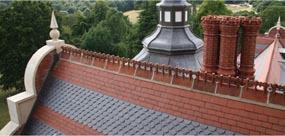Sustainability
Dreadnought clay roof tiles are a truly sustainable choice
Download our Sustainability Statement
Place of Manufacture: Brierley Hill, UK
Environmental Management: 14001 Download certificate
Quality Management : 9001 Download certificate
Download our Quality and Environmental Policy
Life Cycle: BRE 'A+' rating
Energy: Fired in gas kilns to 1130 degrees
Raw materials: Etruria Marl Clay from our local quarry in Cannock, sand
Lifespan: > 60 years. Second hand tiles that have been on roofs in excess of 100 years often sell for more than new tiles on the 2nd hand market
Recyclability: Can be crushed and used as aggregate and/or as an inert bulk fill
Packaging: We keep packaging to a minimum using wooden pallets. We do not shrink wrap or use plastic straps.
Sustainable Manufacturing
Dreadnought Tiles have been awarded an SME Decarbonisation Award by the British Ceramics Federation. This award recognises the breadth of decarbonisation projects and activities that are being undertaken. Dreadnought have already cut their carbon emissions by around 30% since 2005 and they are involved in a variety of projects to help achieve net zero targets.
Dreadnought are part of Phase 2 of “Hydrogen for the ceramics sector” project looking at hydrogen as an alternative fuel for the ceramics industry.
They are also working on a heat recovery project to re-use as much of waste heat as possible to supply their brick and tile dryers in order to further reduce their gas consumption.
They have been part of a research and innovation pilot project with Cambridge Carbon Capture looking at converting the CO2 emissions into a solid mineral by-product.
Sustainable Development
Dreadnought products have stood the test of time and have a heritage of 220 years. Their durability and enduring aesthetic ensures a long life, contributing to the sustainability of the built environment.
Sustainable development is about delivering a better quality of life for everyone, now and for generations to come. The Government has defined four key objectives, the integration of which will deliver sustainable development.
- Social progress which recognises the needs of everyone
- Effective protection of the environment
- Prudent use of natural resources
- Maintenance of high and stable levels of economic growth and employment
Prudent use of Natural Resources
Our task is to use our resources as efficiently as possible, to reduce waste, reduce the energy used in manufacture, encourage the re-use of materials and ensure our products have the longest possible lifespan. When looking at energy use it is appropriate that the quantity of resources consumed is evaluated over the whole life of the product. Also the evaluation should cover the total quantity of energy embodied in the product and include all material and energy inputs in the supply chain. Transport is a big issue and special consideration should be given to the environmental costs from imports into the UK of heavy clay products.
Dreadnought tiles manufactured over 100 years ago are still in use today. This surely demonstrates their sustainability. The most relevant measure of sustainability is the embodied energy in their production divided by their useful life.
At Dreadnought Tiles and at our sister company Ketley Brick we are continually investing to make the use of clay as efficient as possible:
- Our quarry is located a few miles from the Works, minimising transport
- We minimise the waste of clay in the production process by recycling unfired clay
- Water pollution is minimised as no stains or pigments are used on Dreadnought Tiles
- We are continually investing in more fuel efficient production. It is imperative in this climate of high energy costs.
A positive contribution to the built environment
The UK has an ongoing need for both new housing and the renovation of existing housing stock to meet the demands of demographic change. Accepted forecasts indicate that around three million homes will need to be built over the next 20 years.
Buildings with Dreadnought Tiles have proved themselves to be sustainable because:
- They are extremely durable. Their longevity is an advantage since the appearance is enhanced with age.
- The traditional colours and patterns of Dreadnought Tiles, make them particularly suitable for renovation and conservation
- Established standards, technical specifications and characteristics ensure Dreadnought Tiles reliability in service
- There is little or no in service maintenance on completed clay roof tile projects.
Visual Environment
The acceptability of built development and its contribution to social progress depends to a large degree on aesthetics. Government advice and planning guidance recognises the importance of design and appearance in producing an environment in which to live and work. Dreadnought Tiles make a significant contribution because:
- Their texture and colour harmonise with our natural surroundings, making them an acceptable part of both urban and rural landscapes
- There is a wide variety of product of differing appearance determined by the clays used and production techniques applied
- The extent of product range permits its use in a wide variety of styles, both by itself and in conjunction with other materials
- Choice of colour, texture and form can preserve continuity within particular locations
- The requirement of planners and architects for materials reflecting local distinctiveness and sense of place can often be met only by Dreadnought Tiles
Energy Consumption
The heavy clay industry is energy intensive, its annual consumption of energy is around 5.4 Terawatt hours. However, this represents less than 1.5% of total consumption by UK manufacturing industry.
Comparative figures for other energy intensive industries are:
Chemicals 89.5 Twh
Iron and Steel 56.0 Twh
Metal 52.3 Twh
Food and beverage 47.4 Twh
Heavy clay 5.4 Twh







-A.jpg)


